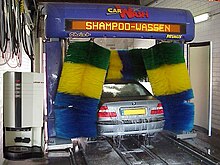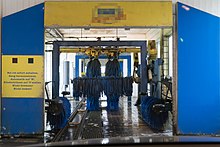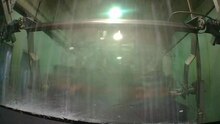Car wash


A car wash is a device that is used to clean the exterior of preferably motorized vehicles such as cars , trucks , buses or trains . Washing facilities for bicycles are rarer , as in the Münster bicycle station . As a rule, a distinction is made between gantry washing systems and car wash systems . A special variant is the tire washing system , which is usually intended for use on construction sites . Due to the closed circuits and the adapted cleaning technology, washing systems are fundamentally more environmentally friendly and more economical in the use of resources than an ad hoc and manual vehicle cleaning.
Portal car wash
In a gantry car wash, the customer has to drive in the vehicle and usually leave it. The cleaning brushes move independently over the vehicle. After inserting punch cards, magnetic cards, chip cards or tokens, the customer can often select the desired cleaning program in self-service mode. Alternatively, the wash program is already stored on the card in other systems, or a previously purchased, one-time valid combination of digits must be entered to activate the wash system.
Car wash
In a car wash, the vehicle is pulled through a kind of tunnel with the help of a conveyor belt. The washing stripes are stationary and only move vertically or horizontally. In newer systems there are linear brush portals that follow the vehicle up to 1.5 meters to ensure thorough front and rear cleaning. A car wash has a much higher capacity than a portal car wash. One advantage of car washes is that the customer usually does not have to leave the vehicle and the wash always takes the same length of time, regardless of the selected program.
Self-service wash box
In addition to the automated variants, there are also washing facilities in which the customer can clean his car himself. These systems are usually divided into separate wash boxes, each with space for a vehicle with standard dimensions. Some facilities also offer open washing areas for larger vehicles such as vans or trucks. The systems are only manned by staff periodically; the customer purchases special washing coins from a machine or throws cash directly into the machine at the washing area. After selecting a cleaning program, the vehicle can be cleaned for a certain period of time with a permanently attached high-pressure cleaner or a foam brush. The vehicle is dried in the air or by manual stripping .
Washing process
The vehicle dimensions are first determined by a sensor; if required, the vehicle can be pre-washed using a high-pressure arc that follows the vehicle; this is necessary for textile washing material. In older systems, rotating brushes move around or over the vehicle during the main wash. The transport through the wash hall is carried out by a conveyor belt with a conveyor roller engaging the left front wheel. According to patent DE 3732542, the vehicle cannot go off track. Movable textile strips and more recently PE foam strips are used in more modern systems . Special rotating brushes often also clean the rims of the vehicle. Depending on the washing program, the vehicle can now be given a wax treatment or underbody preservation , which protects against environmental influences. The last step is drying. A fan moves over the vehicle and dries the body . After the blower drying, modern car washes also have a textile filter that wipes away the remaining water droplets and creates a significantly more glossy finish.
A less common way of having the vehicle cleaned fully automatically are brushless washing portals, which only wash the vehicle clean with extreme pressure (up to 90 bar ) and extremely aggressive cleaning agents. However, the operating costs of such washing systems are comparatively high, since up to six high-pressure pumps are used. These systems are mainly found in the Scandinavian countries, where in winter instead of salt they are spread with grit, which is mixed with bitumen . Brushes would be heavily worn or soiled by this mixture of vehicles. Therefore, cleaning is almost exclusively done with high pressure or brushless in the winter months.
history
In 1961 Gebhard Weigele and Johann Sulzberger (the founders of WESUMAT Autowaschanlagen GmbH ) developed the first car wash that drove around the stationary car to be washed with just two brushes and fit into a normal petrol station wash bay. The patent DE 1187943 for this was applied for on August 8, 1962.
Weigele and Sulzberger applied for patent DE 1294248 on April 9, 1964 for the first fully automatic washing line with a coin-operated machine. For the first time, the customer was able to stay in the car while washing.
In 1963, Franz Christ ( Otto Christ AG) built the first fully automatic car wash, which forms the basis for today's technology.
Brushes or rags
In many new washing systems, instead of brushes, rags are mainly used for cleaning to protect the paint. Compared to nylon brushes, however, these clean less and usually leave behind a fine film of dirt due to the low mechanical impact. Nylon brushes, on the other hand, usually only damage the paintwork if they are not cleaned regularly.
Since the year 2000, washing material made of closed-cell PE foam has been used more and more often instead of nylon or polyethylene bristles or textile rags. At the same speed as polyethylene bristles, the washing result is also good. This washing material leaves less abrasion on the paint and hardly causes any sanding marks from trapped particles. This means that paint damage is less common.
Washing programs
The most common washing programs are:
- High-pressure pre-wash - A high-pressure jet (up to 90 bar) pre-washes the car to remove extreme dirt and sand, which can cause scratches in the brush wash.
- Active foam - the car is sprayed with a highly active cleaning foam that loosens stubborn dirt in order to prepare the paintwork for brush washing.
- Brush washing - The vehicle is scanned by three brushes (two vertical, one horizontal) using sensors and pressure sensors and the paint is cleaned in the process.
- Wax application - hot, cold and foam wax are sprayed on after the washing process.
- Special wax - A special wax is sprayed onto the dry paint after drying in between and then fixed by the brushes.
- Foam polish - A special wax is applied to the lacquer as a foam without drying in between and then fixed by the brushes.
- Shine dryer / drying aid - An agent is sprayed on before the drying process and causes the water film to run off as quickly as possible.
- Drying - A horizontal blower (optionally also a side blower) follows the contour of the vehicle and blows off the remaining water droplets.
- Underbody washing - The underbody and the wheel arches are cleaned by high-pressure nozzles with up to 90 bar.
- Underbody preservation - the underbody is sprayed with a special wax to protect it from stones and salt.
- Rim cleaning - The rims are cleaned by means of plate brushes or high-pressure nozzles.
environmental Protection
Depending on the type of car wash, between approx. 120 l (gantry car wash) and 600 l (car wash) of water are used to wash the vehicle . In order to save fresh water, the washing water is collected in most washing systems and used again for washing after clarification and filtering. However, waxes and drying aids are always applied with fresh water. Detergent additives are added to the washing water to remove stubborn dirt. In addition, the washing water is slightly basic ( pH 7.5 to 8.0). Oils or operating materials escaping from the vehicles are filtered out by an oil separator . In the winter months, road salt is also brought into the washing water by the vehicles, which leads to an increase in salt in the washing water. Therefore, fresh water is added periodically in winter to stabilize the salt concentration at a lower level.
Wash systems for large military vehicles
A special effort is associated with automatic washing and decontamination systems for tanks and other military vehicles. It is caused by the enormous weight of the vehicles, the extensive and possibly contaminated dirt residues, as well as contamination emanating from the vehicle, for example through oil leaks.
Tank washes are important facilities on training grounds and larger military sites. After maneuvers and combat missions, they enable the entire vehicle technology to be freed of coarse dirt quickly and intensively in a comparatively environmentally friendly manner, in order to make the vehicles ready for use again and restore transportability on public roads and railways. Manufacturers include the Swiss company Frutiger and Kärcher Futuretech .
Tank washing systems themselves are a possible source of environmental pollution due to oil leaks, among other things. Even more harmful to the environment was the cleaning method used by the group of the Soviet armed forces in Germany , simply hosing tanks roughly on rivers and simply dumping the oil into the ground. In the case of renaturation measures at former military training areas, the catchment basins are suitable as biotopes for amphibians .
Web links
Individual evidence
- ^ Army without a future: the end of the NVA and German unification: reports from contemporary witnesses and documents, Hans Gotthard EhlertCh. Links Verlag, 2002
- ↑ Saved landscapes: 40 hikes to Bavarian nature conservation successes. With GPS data. Winfried Berner, Ulrike Rohm-Berner, Bergverlag Rother, 2015
- ↑ Entry on tank washing facility at Camp Major Legrand (near Troisdorf-Altenrath) in the database " KuLaDig " of the Rhineland Regional Association , accessed on February 15, 2017.








